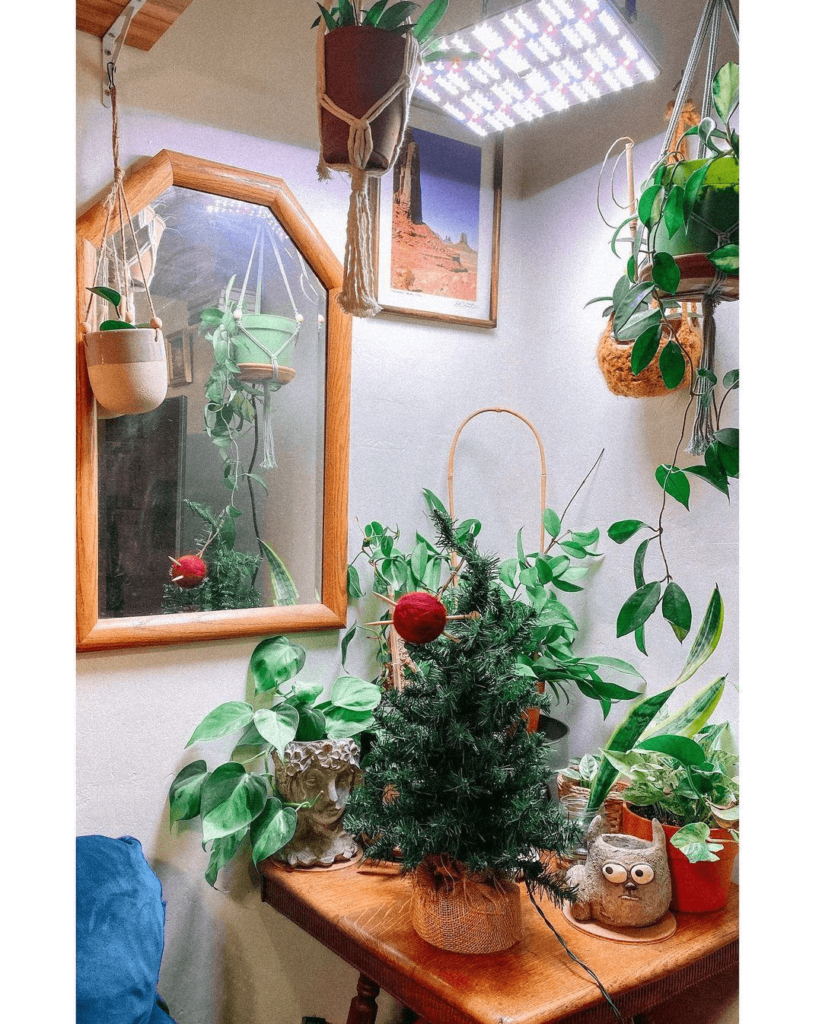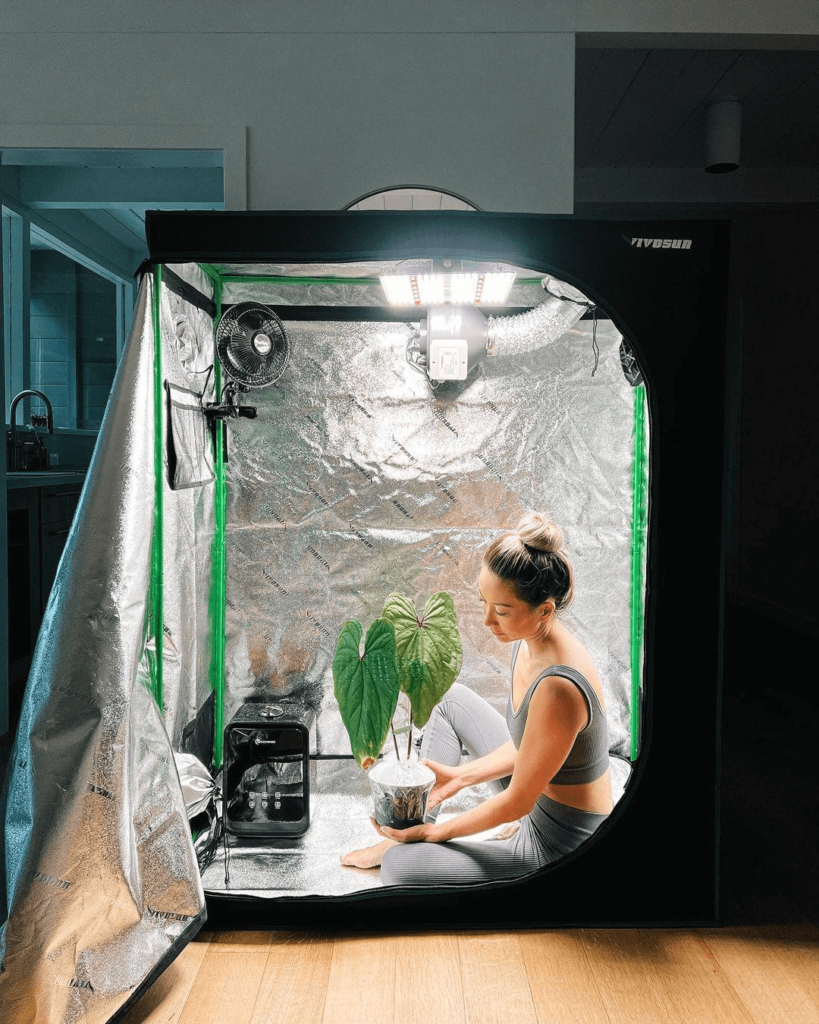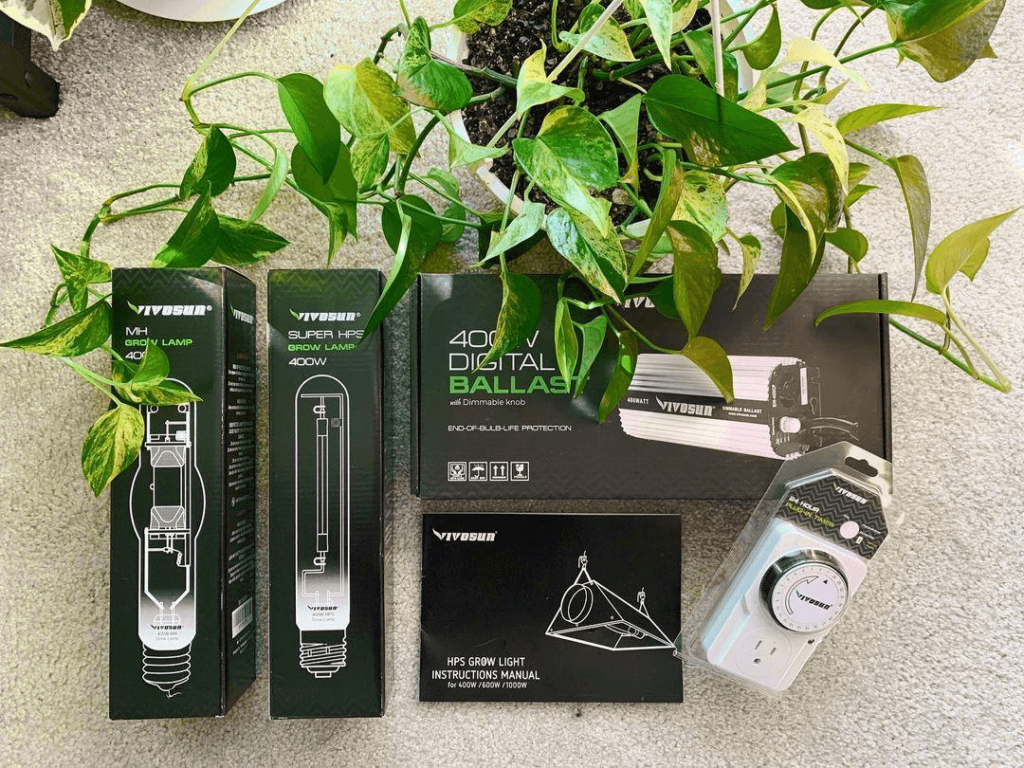Growing plants inside or in a grow tent might be seen as a pretty big challenge because you are trying to recreate the perfect growing environment for your plant. In order to do so, we need to find the perfect light that mimics the sunlight in your plant’s home environment, as well as recreate humidity, temperature, and airflow.
We want to dedicate this post to explaining the practical differences between different grow lights so you can give your plants the best home. So, what type of grow light is best for your situation? Let’s think about it critically.
There are 3 main types of grow lights on the market today:
LED Grow Lights – What Type of Grow Light is Best for Indoor Plants
LED grow lights are a specialized type of technology that uses a microchip to control electrical currents through a superconductor and then through a light-emitting diode (LED). When an electrical current flows through the LED, you create a spectrum of light.
| Benefits of LEDs | Drawbacks of LEDs |
| Provide a full spectrum of light | A higher initial cost |
| Adjustable brightness and light spectrum | May not heat a tent in a cold environment |
| Energy efficient | New technology means that some people are nervous about its effectiveness |
| Long Lifespan, up to 50,000 hours of use | Lack of industry standardization means that it can be difficult to find a reliable supplier |
| Produce little heat | Has lower light levels than HPS systems |
| No extra equipment is needed (such as a ballast) | |
| Light, simple to use | |
| Can be programmed as they include a computer chip | |
| Low electricity use means low electricity bills | |
| Proven effective with high yields |
Fluorescent Grow Lights – What Type of Grow Light is Best for Indoor Plants
Fluorescent grow lights (T5, T8, T12 tubes, and CFLs) make electrical energy convert to light by running a current through a low-pressure mercury vapor, which creates ultraviolet radiation and ultimately is emitted into a color that is determined by the quantity of phosphorus. They are most beneficial for short, flat plants.
| Benefits of Fluorescent Bulbs | Drawbacks of Fluorescent Bulbs |
| Energy efficient | High initial cost since you will also need to buy a fixture |
| Easy-to-use | Does not produce much heat or light |
| Low light and temperature are great for low-light plants | Mercury is toxic so the lights cannot be disposed of easily |
| You can place fluorescent lights close to your plants | Very limited in its scope of uses—not great for any high-level plants or any flowering plants beyond the seedling stage |
| Not expensive for electricity | Smallest yield per watt of all light types on the market |
| Long light life |
HPS Grow Lights – What Type of Grow Light is Best for Indoor Plants
High-Pressure Sodium (HPS) lights have been around for over a century. Similar to fluorescent bulbs, light is created by running an electric current through a pressurized tube that contains a highly pressurized sodium gas. When the sodium vapor heats up it begins to glow a yellowish orange color. HPS bulbs have had a great track record so it is no surprise a lot of growers are interested in them. Yet, there are still some drawbacks, especially when comparing them to new technology:
| Benefits of HPS Bulbs | Drawbacks of HPS Bulbs |
| Relatively low initial cost (including fixture) | Shorter lifespan (20,000—25,000 hours) but intensity goes out sooner than that |
| Highest yield to watt | High heat and noise; cannot be hung close to canopies |
| Decades of reliable yield data | Not suitable for small spaces |
| Produce UV light that stimulates terpenes and resin production | While they can be used for a full grow cycle, they do not have high blue-light levels and should be paired with MH/CMH bulbs for the best results |
| Can heat a tent efficiently if you are in a cold environment | Can be damaged by oil from your skin |
| Double-ended HPS bulbs are 30% more efficient than single-ended ones and produce excellent results | Can be a fire hazard if installed incorrectly |
| You can buy kits that have air-cooled options | Require a ballast to operate |
| High cost of electricity so long-term cost may outweigh short-term savings | |
| Not environmentally-friendly |
What to consider when choosing your grow light?
When growing cannabis, there are really only two options you should consider for the life of the plant: LED and HPS. Unfortunately, fluorescent bulbs simply do not produce enough energy to grow flowers efficiently, so they are off the table for cannabis, except during the seedling stage. That said, if you plan to grow low-light plants or low-light tropical plants (think orchids), fluorescents are perfect.
Regarding cannabis, what type of grow light is best for your growing? There is no right answer. You will find a lot of discussion online touting either LED or HPS systems and indeed both work incredibly well for growing indoors. You need to consider your own situation: are you growing in a garage in the New England winter? You’ll probably need sources of heat so HPS may work better (be sure to add a space heater, too). Are you conscious of your electric bill? LEDs are a better bet. Consider your goals, your budget, and your environment, and go from there.
How much room do you have?
LED lights need to hang at least 14 to 24 inches above the plants you grow, it is important to consider the vertical space. However, fluorescent lights only need to hang around 3 inches above the plants. HPS bulbs need to be at least 24 inches above your canopy or you’ll risk burning.
What plants are you growing?
Of course, you should start here when choosing a light. If you are planning to grow fruiting plants like cannabis or tomatoes, fluorescent bulbs probably won’t cut it. If you are growing orchids, LEDs and HPS bulbs could easily kill them.
Grow Light Placement Tips
- Always hang your lamps directly above your plants. You want to mimic sunlight as best you can and optimal sunlight is when the sun is highest in the sky. This way, you’ll give your plants the most access to that electric energy.
- Experiment with distances between the light and your plant. Through observation and testing, you’ll find the right height for your situation.
- Different plants have different characteristics—be sure to do research about your specific plant and find the right light level for it. We also recommend doing your research when choosing a strain of cannabis, since strains also have minor differences in preference.

Wrap-up – What Type of Grow Light is Best for Indoor Plants
Indoor grow lights are great for either the entire lifecycle of a plant or if you’re just preparing your plant for summer. Different lights have different benefits and drawbacks so we hope this blog helps you parse out the specific limitations of each light. What type of grow light is best depends on your needs, just be sure to do your research!
If you have any questions, please don’t hesitate to reach out to us!
And be sure to check out our other blog posts for useful tips on becoming a great grower!
Subscribe to the VIVOSUN newsletter for growing tips, grower stories, and special offers, and get 12% off your first order!
We love the new VIVOSUN Smart Grow System and we are certain that you too will love it once you try it. The smart grow system can be entirely automated, so you can control your grow space and equipment wherever you go. It’s high time we made growing step into a more modern time!
And join our Facebook farmer’s community for even more exclusive contests and prizes!
Download VIVOSUN App to get 18% off and explore more information!








